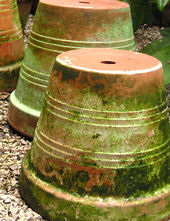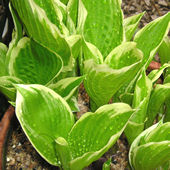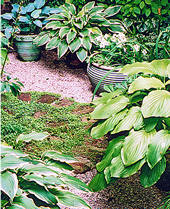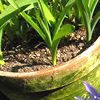The first garden I made was all in containers, in a concreted yard. Though I now have 'proper soil' to plant in, I still keep a large number of plants in containers.
Containers are versatile and portable, and can either be made a feature of, or placed in the middle of a flowerbed to fill a gap. Best of all, when you move house you can take them with you. Many plants in my current garden originally grew in my first yard garden.
The ideal pot
I prefer round pots to square or rectangular ones, though of course the square and rectangular ones are better if you want to place them against a wall. In this garden attached to a Victorian house, I find that natural materials look better than plastic, though I notice that there are more and more pots available that are made of various kinds of plastic doing a passable imitation of stone or lead.
Bright new plantpots of orangey terracotta I often paint with a diluted wash of cream or grey or very pale blue water-based paint - emulsion paint usually, thinned a bit with water, roughly brushed on, then wiped around with a rag. This helps them blend in until they weather a bit. Obviously you should do this when the pot is empty, but I have to confess to occasionally painting pots with the plants already in them.
Portable planting
The most appealing factor, to me, is that plants in pots are portable. It means you can move them not just a few inches, to perfect your display, but take them with you when you move.
When we moved from that house with the tiny yard garden, we had one of those large self-drive Luton vans. We needed only two journeys, not owning a vast amount of furniture.
The second load was just plants. Including one full-sized 'half barrel', containing three climbers. I really don't know how we managed to get it into the van. I'd planned the plant move more carefully than I'd planned moving all the other stuff, and I fretted every time we went over the ubiquitous speed bumps, with the jungle waving around in the back of the van behind us.
The plants in containers, some of which were well-grown specimens in large pots, including one very fine Choisya ternata, formed the backbone of the garden I have now. It was good to have larger plants ready to plant out. I couldn't have left them all behind, whatever. I'd lovingly nurtured them for many years, and the Choisya in particular was a special plant, as it was the first plant I'd bought for my backyard garden.
I even took climbers, the smaller ones at least, by pruning them to free them from the trellises or walls they were growing up.
Aside from the larger journeys, the plants can be moved on far shorter journeys, around the garden. Portable plants in pots allow you to change the way your garden looks. This means that you can entertain yourself for a long while just moving them about to see what looks best where.
Gardeners who have carefully planned borders they want to change can do all this moving about too, but it's essentially messier, and more hassle. If you're digging things up you can't do as you can when moving pots about, which is spend a pleasant hour outside in the evening with a glass of wine in the other hand while you 'work'. Obviously heavier or larger pots involve both hands, so I find it's handy to have a table nearby as well, to put the wine on.

Above: weathered plantpots, originally painted.

Above: potted hosta, in Kitchen Corner, spring 2005

Above: Kitchen Corner, with hostas in pots

